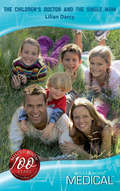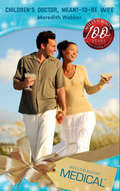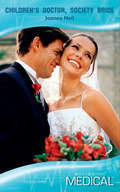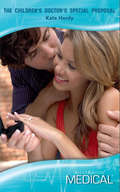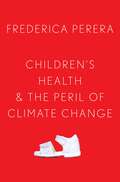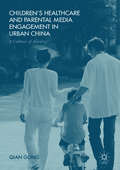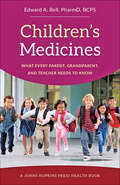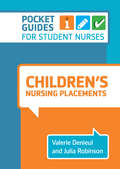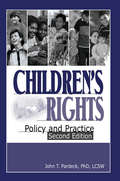- Table View
- List View
The Children's Doctor and the Single Mum (Mills And Boon Medical Ser.)
by Lilian DarcyEnter into the world of high-flying Doctors as they navigate the pressures of modern medicine and find escape, passion, comfort and love – in each other’s arms! The doctor takes a family!
Children's Doctor, Meant-to-be Wife: Marrying The Millionaire Doctor / Children's Doctor, Meant-to-be Wife / A Bride And Child Worth Waiting For (Crocodile Creek #3)
by Meredith WebberEnter into the world of high-flying Doctors as they navigate the pressures of modern medicine and find escape, passion, comfort and love – in each other’s arms! Top-Notch Doc, Top-Notch Husband
Children's Doctor, Shy Nurse (Mills And Boon Medical Ser.)
by Molly EvansDr Mark Collins feels he's on borrowed time, and is determined to make the most of his new job. Timid nurse Ellie Mackenzie has the same idea – until she meets Mark, her new boss! As work forces their lives to intertwine, it's clear they each hold the key to healing the other's heart…
Children's Doctor, Society Bride: Posh Doc Claims His Bride / Surgeon Boss, Surprise Dad / Children's Doctor, Society Bride / The Royal Doctor's Bride / The Doctor Claims His Bride / The Rebel Surgeon's Proposal (Mills And Boon Medical Ser.)
by Joanna NeilMillionaire doctor: wife wanted! Dr Louise Bridgford is devoted to her job on a busy A&E children’s ward. Although her tireless work leaves her little time for romance, she can’t help noticing the devastatingly handsome Dr James Ashleigh – also known as the next Lord Ashleigh!
The Children's Doctor's Special Proposal: The Secret Wedding Dress / The Millionaire's Marriage Claim / The Children's Doctor's Special Proposal (The London Victoria #2)
by Kate HardyA special bride for a special doctor
Children’s Experience, Participation, and Rights During COVID-19
by Ruby Turok-SquireThis edited volume examines how opportunities to realise children’s rights and the experience of childhood itself have been changed by the pandemic. It brings together the voices of leading scholars, policy advisors, psychologists, charities engaged in empowering children, and children and young people themselves. By exposing children’s own perspectives and ideas for change, the book aims to suggest ways in which children could be better supported during this crisis. Chapters connect the experiences of under-represented groups, including children with disabilities and housing-distressed children. Authors illuminate ways to see and hear children more clearly and enable children’s participation during and beyond COVID-19.This book is part of a mini-series that explores the effects of COVID-19 on children’s education, rights and participation. These books will expose and connect the struggles faced by particularly vulnerable children, including children with disabilities, housing-distressed children, and refugee and displaced children. They will explore how best to listen to and support children in diverse situations, in order to enable them to realise their rights more effectively.
Children's Health and the Peril of Climate Change
by Frederica PereraToday, approximately two billion children breathe toxic air at levels exceeding standards set by the World Health Organization, causing immediate and long-term physical and mental health effects. Nearly every child around the world is at risk from at least one climate-related shock such as severe heat, flooding, drought, air pollution, forest fires, water scarcity, and displacement. Air pollution and climate change, largely driven by emissions from fossil fuel, are widening inequality in children's health. From urban centers in the United States to remote villages in the furthest corners of Asia, we are seeing the effects of our inaction on climate change affecting the next generation--even those still in utero. The global transition away from fossil fuel to a low carbon economy creates a major opportunity for the health and future of our children, but only if we all take action. Children's Health and the Peril of Climate Change brings to light the mental and physical harms to children's health inflicted by climate change and its root cause--our addiction to fossil fuel. Drawing on the author's extensive expertise in children's environmental health, this essential and thought-provoking text exposes the unique vulnerability of the developing child and the multiple and synergistic effects of climate change and air pollution on child health, especially for disadvantaged children. However, it also shows how all children, regardless of their generational wealth or birth country, are imperiled by climate change. While this book provides specific evidence for the escalating dangers of climate change, it also presents a roadmap to a brighter future with case studies of climate change and air pollution policies that have benefitted children's health and the economy. Through facts and compelling storytelling, Frederica Perera shares the growing power of advocacy by youth, environmental justice, and Indigenous groups. She describes the many solutions now available, highlighting the need for integrated climate and social policies to accelerate the transition into a zero-carbon future. Leveraging the universally shared value of protecting children, Children's Health and the Peril of Climate Change is a call to action to replace denial and despair around climate change with purpose and commitment for a healthier, more sustainable future.
Children's Health and the Peril of Climate Change
by Frederica PereraToday, approximately two billion children breathe toxic air at levels exceeding standards set by the World Health Organization, causing immediate and long-term physical and mental health effects. Nearly every child around the world is at risk from at least one climate-related shock such as severe heat, flooding, drought, air pollution, forest fires, water scarcity, and displacement. Air pollution and climate change, largely driven by emissions from fossil fuel, are widening inequality in children's health. From urban centers in the United States to remote villages in the furthest corners of Asia, we are seeing the effects of our inaction on climate change affecting the next generation--even those still in utero. The global transition away from fossil fuel to a low carbon economy creates a major opportunity for the health and future of our children, but only if we all take action. Children's Health and the Peril of Climate Change brings to light the mental and physical harms to children's health inflicted by climate change and its root cause--our addiction to fossil fuel. Drawing on the author's extensive expertise in children's environmental health, this essential and thought-provoking text exposes the unique vulnerability of the developing child and the multiple and synergistic effects of climate change and air pollution on child health, especially for disadvantaged children. However, it also shows how all children, regardless of their generational wealth or birth country, are imperiled by climate change. While this book provides specific evidence for the escalating dangers of climate change, it also presents a roadmap to a brighter future with case studies of climate change and air pollution policies that have benefitted children's health and the economy. Through facts and compelling storytelling, Frederica Perera shares the growing power of advocacy by youth, environmental justice, and Indigenous groups. She describes the many solutions now available, highlighting the need for integrated climate and social policies to accelerate the transition into a zero-carbon future. Leveraging the universally shared value of protecting children, Children's Health and the Peril of Climate Change is a call to action to replace denial and despair around climate change with purpose and commitment for a healthier, more sustainable future.
The Children's Health Insurance Program: Past and Future
by David G. SmithThe Children's Health Insurance Program was crafted in a period of intense partisan and ideological controversy over health care entitlements to provide -creditable coverage- for American children below 200 percent of the Federal Poverty Level. This objective was widely supported, though achieved only by a compromise between the structural alternatives of a block grant, similar to the Maternal and Child Health Block Grant or an entitlement resembling Medicaid. According to David G. Smith, the CHIP compromise has been a successful experiment that far exceeded expectations, both in identifying and enrolling -targeted low-income children- and in earning political capital. He argues that beyond this core mission, the reauthorization of CHIPRA (Children's Health Insurance Program Reauthorization Act of 2009) invites a larger mission: going beyond enrollment of children to include assuring access, improving quality, and containing costs of health care for them. Extending this thrust, the author notes that CHIP could be used to establish children's health as a niche--much like care for the elderly--within the larger scheme of health care insurance for all. Several areas of successful performance needed for the program to be adjudged a success as well as its limitations are discussed in the book. These areas include initial implementation, enrolling kids, federal-state relations, and the uses and misuses of waivers to modify the program. A description of changes made by the CHIPRA reauthorization and the new Patient Protection Affordable Care Act (PPACA) is also included. This is followed by a consideration of lessons learned from CHIP's evolution and recommendations for future development. In short, this is a valuable and readable account for those interested in the current and future trends of health care for the young.
The Children's Health Insurance Program: Past and Future
by David G. SmithThe Children's Health Insurance Program was crafted in a period of intense partisan and ideological controversy over health care entitlements to provide -creditable coverage- for American children below 200 percent of the Federal Poverty Level. This objective was widely supported, though achieved only by a compromise between the structural alternatives of a block grant, similar to the Maternal and Child Health Block Grant or an entitlement resembling Medicaid. According to David G. Smith, the CHIP compromise has been a successful experiment that far exceeded expectations, both in identifying and enrolling -targeted low-income children- and in earning political capital. He argues that beyond this core mission, the reauthorization of CHIPRA (Children's Health Insurance Program Reauthorization Act of 2009) invites a larger mission: going beyond enrollment of children to include assuring access, improving quality, and containing costs of health care for them. Extending this thrust, the author notes that CHIP could be used to establish children's health as a niche--much like care for the elderly--within the larger scheme of health care insurance for all. Several areas of successful performance needed for the program to be adjudged a success as well as its limitations are discussed in the book. These areas include initial implementation, enrolling kids, federal-state relations, and the uses and misuses of waivers to modify the program. A description of changes made by the CHIPRA reauthorization and the new Patient Protection Affordable Care Act (PPACA) is also included. This is followed by a consideration of lessons learned from CHIP's evolution and recommendations for future development. In short, this is a valuable and readable account for those interested in the current and future trends of health care for the young.
Children’s Healthcare and Parental Media Engagement in Urban China: A Culture of Anxiety?
by Qian GongThis book analyses parental anxieties about their children’s healthcare issues in urban China, engaging with wider theoretical debates about modernity, risk and anxiety. It examines the broader social, cultural and historical contexts of parental anxiety by analysing a series of socio-economic changes and population policy changes in post-reform China that contextualise parental experiences. Drawing on Wilkinson’s (2001) conceptualisation linking individual’s risk consciousness to anxiety, this book analyses the situated risk experiences of parents’ and grandparents’, looking particularly into their engagement with various types of media. It studies the representations of health issues and health-related risks in a parenting magazine, popular newspapers, commercial advertising and new media, as well as parents’ and grandparents’ engagement with and response to these media representations. By investigating ‘a culture of anxiety’ among parents and grandparents in contemporary China, this book seeks to add to the scholarship of contemporary parenthood in a non- Western context.
Children's Intonation: A Framework for Practice and Research
by Bill Wells Joy StackhouseChildren’s Intonation is a practical guide that focuses on the nature, causes and assessment of intonation problems for children and adolescents. Highlighting the importance of intonation for everyday conversational interaction and the implications of this for teaching and therapy contexts, this book addresses the following questions: How and when do children learn to use intonation for the purposes of interaction? As children get older, does intonation become more important or less important for communication? How might intonation be used to support or compensate for other aspects of language? What are the implications for practitioners, parents and caregivers when interacting with young children? Clinically oriented, this book explores these questions through case studies that cover a range of developmental communication difficulties including autism spectrum disorders, hearing impairment and specific speech and language difficulties. It provides readers with a tool for profiling children’s intonation skills, a developmental phase model to explain typical and atypical intonation development, a psycholinguistic model of intonation processing, interactional perspectives on intonation use, and consideration of intonation in relation to both written and spoken language. It also includes acccess to a companion website with extra resources.
Children's Intonation: A Framework for Practice and Research
by Bill Wells Joy StackhouseChildren’s Intonation is a practical guide that focuses on the nature, causes and assessment of intonation problems for children and adolescents. Highlighting the importance of intonation for everyday conversational interaction and the implications of this for teaching and therapy contexts, this book addresses the following questions: How and when do children learn to use intonation for the purposes of interaction? As children get older, does intonation become more important or less important for communication? How might intonation be used to support or compensate for other aspects of language? What are the implications for practitioners, parents and caregivers when interacting with young children? Clinically oriented, this book explores these questions through case studies that cover a range of developmental communication difficulties including autism spectrum disorders, hearing impairment and specific speech and language difficulties. It provides readers with a tool for profiling children’s intonation skills, a developmental phase model to explain typical and atypical intonation development, a psycholinguistic model of intonation processing, interactional perspectives on intonation use, and consideration of intonation in relation to both written and spoken language. It also includes acccess to a companion website with extra resources.
Children's Medicines: What Every Parent, Grandparent, and Teacher Needs to Know (A Johns Hopkins Press Health Book)
by Edward A. BellMost parents have worried about the side effects and possible long-term consequences of administering a particular medication to their child. The medication may be available over-the-counter, like cough syrup, or it may be prescribed by a doctor, like an antibiotic. Parents want to know: Is the medication safe? Is it effective? Will it help my child? A pediatric pharmacist for nearly thirty years, Edward A. Bell has spent his career listening carefully to parents' concerns. In Children's Medicines, Bell draws on the latest scientific information, coupled with his experience in hospital and clinic settings, as a university professor, and as a parent, to answer questions about whether, when, and what medications to give to infants, children, and teenagers. Bell touches on practical issues of medication administration and explores areas of particular concern for parents.Inside the book, readers will find;€¢ information to help parents weigh the benefits and risks of medicines ;€¢ an explanation of why some adult medications are not safe for children ;€¢ descriptions of medicine for treating fever and common illnesses;€¢ practical tips on measuring, flavoring, and administering medicines;€¢ directions for giving medicine in the mouth, the nose, the ear, and the eye ;€¢ advice for keeping children of any age safe around medications ;€¢ facts about vaccinations: how they work, which ones are recommended, and their safety ;€¢ a guide to the FDA's approval process for use of medicines by children;€¢ information about drug pricing, expiration dates, and storing medicine at home;€¢ a chapter on ADHD and the treatment of adolescent depression that takes into account the long-term side effects of antidepressants;€¢ details about the use of herbal and complementary therapies, including probiotics and vitamins ;€¢ a discussion of over-the-counter cough/cold products;€¢ information on which websites to use for accurate medical and drug informationFull of information helpful to parents, grandparents, and others who provide care for children, Children's Medicines is a reliable and insightful guide to how drugs for children of all ages are prescribed and used.
Children's Medicines: What Every Parent, Grandparent, and Teacher Needs to Know (A Johns Hopkins Press Health Book)
by Edward A. BellMost parents have worried about the side effects and possible long-term consequences of administering a particular medication to their child. The medication may be available over-the-counter, like cough syrup, or it may be prescribed by a doctor, like an antibiotic. Parents want to know: Is the medication safe? Is it effective? Will it help my child? A pediatric pharmacist for nearly thirty years, Edward A. Bell has spent his career listening carefully to parents' concerns. In Children's Medicines, Bell draws on the latest scientific information, coupled with his experience in hospital and clinic settings, as a university professor, and as a parent, to answer questions about whether, when, and what medications to give to infants, children, and teenagers. Bell touches on practical issues of medication administration and explores areas of particular concern for parents.Inside the book, readers will find;€¢ information to help parents weigh the benefits and risks of medicines ;€¢ an explanation of why some adult medications are not safe for children ;€¢ descriptions of medicine for treating fever and common illnesses;€¢ practical tips on measuring, flavoring, and administering medicines;€¢ directions for giving medicine in the mouth, the nose, the ear, and the eye ;€¢ advice for keeping children of any age safe around medications ;€¢ facts about vaccinations: how they work, which ones are recommended, and their safety ;€¢ a guide to the FDA's approval process for use of medicines by children;€¢ information about drug pricing, expiration dates, and storing medicine at home;€¢ a chapter on ADHD and the treatment of adolescent depression that takes into account the long-term side effects of antidepressants;€¢ details about the use of herbal and complementary therapies, including probiotics and vitamins ;€¢ a discussion of over-the-counter cough/cold products;€¢ information on which websites to use for accurate medical and drug informationFull of information helpful to parents, grandparents, and others who provide care for children, Children's Medicines is a reliable and insightful guide to how drugs for children of all ages are prescribed and used.
The Children's Nurse: The True Story of a Great Ormond Street Nurse
by Susan MacqueenThe memoir of a Great Ormond Street nurse.This is the inspirational story of life as a nurse during the 1960s, 70s and 80s, most of which was spent at Great Ormond Street Children's Hospital. Susan Macqueen was 12 years old when she accompanied her mum to see her friend Ms Fairweather, the matron at the local nursing home and from that day on she knew she wanted to be a nurse. A few years later, despite being told that her grades weren't good enough and having left school with only two O-Levels, Susan was accepted on the three-year nurses training course at Addenbooke's hospital in Cambridge. It wasn't long before Susan knew she wanted to work with children and set her sights on a job at Great Ormond Street. Thirty-five years later, on her third attempt, Susan has finally retired from that iconic hospital and is enjoying a more leisurely pace of life.Hope, despair, laughter and tears, Susan's stories move the reader through the incredible stories that she was faced with on an every day basis.
Children's Nursing Case Book (UK Higher Education OUP Humanities & Social Sciences Health & Social Welfare)
by Tony LongNursing children and young people is increasingly complex requiring nurses to apply their knowledge and skills to a wide scope of illnesses and situations. The challenges to nurses to analyse, reflect on different perspectives and then adapt practices to the benefit of service users are reflected in this book.Each scenario in this text is created based on real life cases and practice. The 23 cases connect knowledge with practice and guide you through the anatomy and physiology and the physical and psychological responses to stressors, which are then linked to intervention decisions. Cases include:• Providing care for children and young people with life-limiting conditions• Acutely ill children including those with asthma, and an infant with pyrexia and febrile convulsions• Long term conditions including diabetes, renal disease and the transfer to adult services• Those who are critically ill such as a child with typhoid fever and a toddler with a head injury• Supporting emotional and mental health in anorexia and autistic spectrum disorder• Promoting healthy lifestyles, considering obesity and risky behaviour• Care for children with trauma, including a child with a learning disability Remaining vigilant for indicators of safeguarding concern, encouraging self-care, and promoting mental resilience are all incorporated, with examples from a range of care environments. Calculation exercises are interspersed to keep these skills sharp.This Case Book is an ideal learning resource, tailored to help nurses learn in a focused way about practice and excel, whether on placements, in academic work, or in professional practice."Developed from a partnership between a University Research Group and an NHS Trust, this practical children’s nursing case textbook bridges theory and practice by presenting 23 case scenarios on complex, sensitive and difficult to manage clinical situations in an accessible and user-friendly manner. The inbuilt activities, calculation exercises, question and answer format and extra resources make this an excellent interactive resource for nurses to engage in critical thinking and reflection about each case."Dr. Veronica Lambert, Senior Lecturer Children's Nursing, Dublin City University, Ireland"This book will be useful for nurses in the UK who work with children and families in a variety of settings. Its format based on case studies and 'what would you do' and 'what do you need to do' scenarios will make it a useful tool for teaching clinical care for children and families."Professor Linda Shields, School of Nursing, Midwifery and Indigenous Health, Charles Sturt University, Bathurst, Australia"What Tony Long has achieved is to produce a textbook with contributions from esteemed practicing children’s nurses which gives enhanced credibility to each of the case studies. Tony and his colleagues have created these case studies to help children’s and young people’s nurses fully understand the complexities of the needs of both children and their families or carers during their healthcare trajectory. This new book crucially never forgets the primary mission of the children’s nurse which is to uphold their mantra of 'the child first and always'."Alan Glasper, Emeritus Professor of children’s and young people’s nursing at the University of Southampton, UK
Children's Nursing Placements: A Pocket Guide (Pocket Guides)
by Valerie Denieul and Julia RobinsonA handy, pocket-sized guide designed to make placements more enjoyable and less stressful for children's nursing students. Children’s nursing placements can be daunting – you’ll be working in a variety of settings and caring for a range of children and their families when they are at their most vulnerable. You will have new colleagues to work with, and newly learned nursing theory to put into practice. This pocket guide is designed to make your placements much more enjoyable and less stressful.
Children’s Orthopaedics and Fractures
by Michael Benson John Fixsen Malcolm Macnicol Klausdieter ParschCon?rming the British genetic trait for writing and publishing (as well as acting), two English (Oxford and London) and a Scottish orthopaedic surgeon (Edinburgh) have produced a third edition of their comprehensive text, joined, as in the second edition by an editor from Germany, recognizing its part in the European community. The 62 physician contributors are drawn from pink-colored countries in our childhood geography books—the old British Empire from Australia to Zambia and two from the former colony, the USA. The original purpose of the book was to give residents or registrars an easily accessible and concise description of diseases and conditions encountered in the practice of paediatric orthopaedic surgery and to prepare for their examinations. But the practicing orthopaedic s- geon will ?nd an update of current practice that can be read for clarity and constraint—enough but not too much. A foreword might be a preview of things to come, but a “back word” of what was thought to be the ?nal say on the subject is needed for a perspective in progress. A “back word” look reveals the tremendous progress in medical diagnosis and treatment of which paediatric orthopaedics and fracture care is a component. Clubfoot treatment based on the dictums of Hiram Kite has had a revolutionary change by Ponseti. The chapter by Eastwood has the details on cast application and orthotics follow-up to obtain the 95% correction without the extensive surgery many of us thought was needed.
Children’s Palliative Care: An International Case-Based Manual
by Julia DowningThis manual enables individuals working in children’s palliative care (CPC) globally to learn through engaging real-world cases. The aim is to provide a clinical case-based resource that is globally relevant and accessible to those working in CPC. Drawing on case histories from around the world that reflect key issues and elements of CPC, it provides a practical approach grounded in experience. It addresses multidisciplinary care in the management of children and their families; discusses cases from an international perspective, and shares examples from a variety of countries, utilising cases across a range of ages and conditions, demonstrating holistic care. It represents the first case-based manual on global CPC and is endorsed and promoted by the International Children’s Palliative Care Network (ICPCN). Children’s palliative care is a rapidly developing field, both in the UK and internationally. The provision of CPC varies considerably, with provision often being insufficient, and over 65% of countries having no recognised CPC service provision whatsoever. As such, while there are an estimated 21.6 million children who require palliative care, in many areas of the world, CPC is poor or non-existent, and children are treated like little adults without their distinctive needs being recognised or understood. There is also a dearth of literature on CPC, hence this clinical case-based manual fills a gap in the market, and is aimed at a global audience, making it a unique text in the field.
Children's Respiratory Nursing
by Janice MightenChildren's Respiratory Nursing is a comprehensive, patient-centred text providing up-to-date information about the contemporary management of children with respiratory conditions. It looks at acute and chronic respiratory conditions in both primary and secondary health care sectors and explores the subject from a child- and family-focused perspective. Children’s Respiratory Nursing is divided into four user-friendly sections: The first section provides a general background for children’s respiratory nursing Section two explores the various investigations that aid diagnosis and treatment, such as assessment of defects in airflow and lung volume, oxygen therapy, and long term ventilation Section three looks at respiratory infection and provides an overview of the common infections in children with reference to national and local guidelines The final section considers the practical issues that impact on children’s nurses - the transition from children to adult services, legal and ethical issues and the professional communication skills needed for dealing with children and their families This practical text is essential reading for all children’s nurses who have a special interest in respiratory conditions and would like to develop a greater level of understanding of the management required. Special Features Examples of good practice provided throughout Includes evidence-based case studies Explores care in both hospital and community settings A strong practical approach throughout
Children's Respiratory Nursing
by Janice MightenChildren's Respiratory Nursing is a comprehensive, patient-centred text providing up-to-date information about the contemporary management of children with respiratory conditions. It looks at acute and chronic respiratory conditions in both primary and secondary health care sectors and explores the subject from a child- and family-focused perspective. Children’s Respiratory Nursing is divided into four user-friendly sections: The first section provides a general background for children’s respiratory nursing Section two explores the various investigations that aid diagnosis and treatment, such as assessment of defects in airflow and lung volume, oxygen therapy, and long term ventilation Section three looks at respiratory infection and provides an overview of the common infections in children with reference to national and local guidelines The final section considers the practical issues that impact on children’s nurses - the transition from children to adult services, legal and ethical issues and the professional communication skills needed for dealing with children and their families This practical text is essential reading for all children’s nurses who have a special interest in respiratory conditions and would like to develop a greater level of understanding of the management required. Special Features Examples of good practice provided throughout Includes evidence-based case studies Explores care in both hospital and community settings A strong practical approach throughout
Children's Rights: Policy and Practice, Second Edition
by Jean A. PardeckGet up-to-date information on children&’s and parent&’s rightsChildren have a basic human right to be free of abuse and maltreatment. The late Dr. John Pardeck&’s Children&’s Rights: Policy and Practice, Second Edition comprehensively explores the latest legal, psychological, sociological, policy, and child advocacy issues dealing with children&’s rights. Essential issues are clearly discussed involving children at home, in school, in foster care, and in residential facilities. This new edition of The Haworth Social Work Practice Press classic examines the practical and ethical issues inherent in balancing a child&’s right to self-determination against the same child&’s need to be protected.Children&’s Rights: Policy and Practice, Second Edition delves deep into the causes of abuse and neglect and offers help for families at risk. Techniques are presented for case and cause advocacy, as well as venues for family and individual therapy. Other discussions address the role and function of child protective services and the juvenile justice system, a review of effective social policy to protect and care for children, family health and children&’s rights issues, and children&’s rights in schools and day care facilities. This essential exploration includes extensive references and notes, a list of Web sites, and a comprehensive glossary of influential legal rulings focusing on children&’s rights.Children&’s Rights: Policy and Practice, Second Edition includes over 100 pages of new and updated material on: new rulings of the Americans with Disabilities Act (ADA) that have implications for children&’s rights legal case studies an overview and analysis of the Leave No Child Behind Act children&’s rights and school violence an expanded discussion on practice interventions focusing on various approaches for helping children adjust to substitute care an expanded examination on advocacy and children&’s rights, with emphasis on legal case studies as a tool for enhancing the rights of childrenBalancing theoretical considerations, solid information, and practical advice, Children&’s Rights: Policy and Practice, Second Edition is an essential resource for child welfare workers, attorneys, educators, students, parents, and social workers.
Children's Rights: Policy and Practice, Second Edition
by Jean A. PardeckGet up-to-date information on children&’s and parent&’s rightsChildren have a basic human right to be free of abuse and maltreatment. The late Dr. John Pardeck&’s Children&’s Rights: Policy and Practice, Second Edition comprehensively explores the latest legal, psychological, sociological, policy, and child advocacy issues dealing with children&’s rights. Essential issues are clearly discussed involving children at home, in school, in foster care, and in residential facilities. This new edition of The Haworth Social Work Practice Press classic examines the practical and ethical issues inherent in balancing a child&’s right to self-determination against the same child&’s need to be protected.Children&’s Rights: Policy and Practice, Second Edition delves deep into the causes of abuse and neglect and offers help for families at risk. Techniques are presented for case and cause advocacy, as well as venues for family and individual therapy. Other discussions address the role and function of child protective services and the juvenile justice system, a review of effective social policy to protect and care for children, family health and children&’s rights issues, and children&’s rights in schools and day care facilities. This essential exploration includes extensive references and notes, a list of Web sites, and a comprehensive glossary of influential legal rulings focusing on children&’s rights.Children&’s Rights: Policy and Practice, Second Edition includes over 100 pages of new and updated material on: new rulings of the Americans with Disabilities Act (ADA) that have implications for children&’s rights legal case studies an overview and analysis of the Leave No Child Behind Act children&’s rights and school violence an expanded discussion on practice interventions focusing on various approaches for helping children adjust to substitute care an expanded examination on advocacy and children&’s rights, with emphasis on legal case studies as a tool for enhancing the rights of childrenBalancing theoretical considerations, solid information, and practical advice, Children&’s Rights: Policy and Practice, Second Edition is an essential resource for child welfare workers, attorneys, educators, students, parents, and social workers.
Children's Speech Sound Disorders
by Caroline BowenSpeaking directly to experienced and novice clinicians, educators and students in speech-language pathology/speech and language therapy via an informative essay-based approach, Children’s Speech Sound Disorders provides concise, easy-to-understand explanations of key aspects of the classification, assessment, diagnosis and treatment of articulation disorders, phonological disorders and childhood apraxia of speech. It also includes a range of searching questions to international experts on their work in the child speech field. This new edition of Children’s Speech Sound Disorders is meticulously updated and expanded. It includes new material on Apps, assessing and treating two-year-olds, children acquiring languages other than English and working with multilingual children, communities of practice in communication sciences and disorders, distinguishing delay from disorder, linguistic sciences, counselling and managing difficult behaviour, and the neural underpinnings of and new approaches to treating CAS. This bestselling guide includes: Case vignettes and real-world examples to place topics in context Expert essays by sixty distinguished contributors A companion website for instructors at www.wiley.com/go/bowen/speechlanguagetherapy and a range of supporting materials on the author’s own site at speech-language-therapy.com Drawing on a range of theoretical, research and clinical perspectives and emphasising quality client care and evidence-based practice, Children’s Speech Sound Disorders is a comprehensive collection of clinical nuggets, hands-on strategies, and inspiration.
